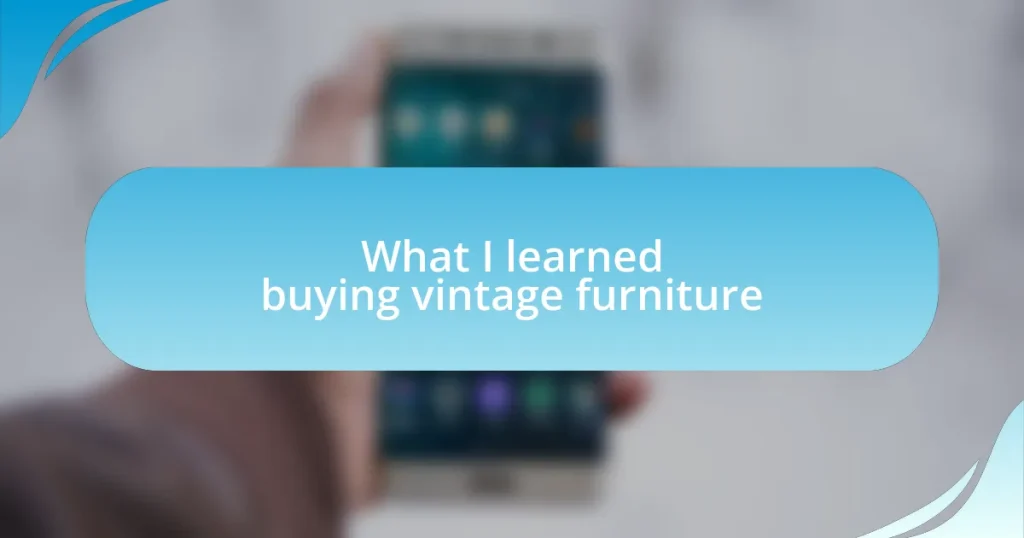Key takeaways:
- Understanding vintage furniture involves appreciating its history, quality, and craftsmanship, which often surpasses that of mass-produced items.
- Investing in vintage furniture supports sustainability, offers character, and can be financially beneficial as pieces may appreciate in value.
- Identifying quality vintage items requires attention to materials, craftsmanship, condition, style, and provenance.
- Negotiating prices effectively involves being confident, researching market values, and being willing to walk away if necessary.

Understanding vintage furniture buying
Understanding vintage furniture buying can feel overwhelming at first. I remember stepping into my first vintage shop, feeling a mix of excitement and confusion. How do you even begin to assess the value of a piece?
Each item tells a story, and getting to know its history can deepen your appreciation. For instance, I once came across a mid-century modern chair that stood out not just for its design, but for the memories I imagined it held. Was it part of a lively dining room filled with laughter or the quiet moments of a solitary reader?
It’s essential to recognize that vintage furniture is not just about aesthetics; it’s also about quality and craftsmanship. I learned that older pieces often exhibit durability that newer, mass-produced furniture simply lacks. Have you ever felt the difference in weight or sturdiness? I find that investing in vintage often means embracing a unique personality that mass-produced items can’t replicate.

Reasons to invest in vintage
Investing in vintage furniture is more than just a design choice; it’s a way to contribute to sustainability. When I first learned about the environmental impact of manufacturing new furniture, it struck me how every vintage piece already existed, conserving resources and reducing waste. I remember coming across a beautifully worn dining table that had seen several family gatherings, and knowing that I was extending its life made the purchase feel even more meaningful.
Moreover, vintage furniture offers unparalleled character that you simply won’t find in contemporary designs. For example, I recall purchasing a retro lamp with an imperfect shade that gave my living room a cozy, eclectic feel. Each scratch and dent told a story, creating a sense of warmth that new items in glossy finish just can’t compete with. Have you ever noticed how a one-of-a-kind piece can spark conversation? That uniqueness can transform a simple space into something memorable.
Lastly, investing in vintage can be a fruitful financial decision. Many vintage pieces appreciate over time, often increasing in value as they become desirable antiques. I have personally witnessed this with a set of 1960s teak chairs that I purchased for a fraction of their current worth. Watching their market value climb has made me appreciate not only their aesthetics but also the financial wisdom behind my choice.
| Reason | Explanation |
|---|---|
| Sustainability | Choosing vintage reduces waste and conserves resources. |
| Character | Unique items create a warm, personal atmosphere. |
| Financial Investment | Vintage pieces often appreciate in value over time. |

Identifying quality vintage pieces
Identifying quality vintage pieces requires a discerning eye and a bit of patience. I often find myself closely examining the craftsmanship and materials of potential purchases. For instance, I once came across a mid-century dresser that caught my attention; the dove-tailed joints indicated a level of quality rarely seen in today’s mass-produced furniture. Each detail tells a story and provides insight into the piece’s integrity.
Here are some key aspects to consider when evaluating the quality of vintage furniture:
- Material: Look for solid wood rather than particle board or veneer, which often indicates better durability.
- Craftsmanship: Check for details like dovetail joints, which signal high-quality construction.
- Condition: Assess any repairs or restorations; they can reveal the piece’s history and value.
- Style and Era: Familiarize yourself with different design movements to appreciate the uniqueness and historical significance of a piece.
- Provenance: Sometimes, the history behind a piece adds to its charm and desirability, making it even more special.
By focusing on these elements, I’ve cultivated a collection that not only looks good but feels fulfilling—each piece resonates with its past, adding layers of meaning to my home.

Researching vintage furniture styles
When I started exploring vintage furniture, I quickly realized that researching different styles is crucial. Each era has distinct characteristics that not only define its aesthetic but also reflect the cultural context of the time. For example, I was fascinated by the organic shapes and vibrant colors of the 1960s, which sparked a sense of nostalgia for the playful spirit of that decade.
I remember stumbling upon a beautiful Art Deco cabinet at a flea market. With its bold geometric patterns and glamorous materials, the piece told me a story of sophistication and modernity from the 1920s. Engaging with online forums or vintage furniture blogs can deepen your understanding of such styles, allowing you to appreciate the nuances that make them special.
Additionally, I often wonder: how can one style evoke such powerful emotions while another falls flat? This curiosity drives me to dig deeper into the history behind each design trend. By connecting with the stories of these styles, I find myself more invested in the pieces I bring into my home, making each acquisition not just a purchase but a meaningful addition to my life.

Know your budget for vintage
Knowing your budget for vintage furniture is more than just setting a limit; it’s about understanding the value of what you’re purchasing. I recall the time I spotted a mid-century chair that had perfect lines and an inviting fabric. I was drawn to it, but when I checked the price tag, I realized it was way beyond my intended budget. That moment taught me the importance of aligning my emotional impulses with practical financial limits.
It can be tempting to fall in love with a piece and overlook the price, especially if it’s an item that resonates with you. Once, I ended up spending more than I planned on a stunning vintage coffee table because it made my heart race. But later, the financial pinch made me rethink future purchases. I learned that sticking to a budget not only helps me save money but also encourages me to be more selective and mindful in my choices.
Developing a budget also opens up opportunities to hunt for bargains. I often explore thrift shops and online marketplaces, where I’ve found incredible deals on vintage treasures. Have you ever experienced the thrill of discovering a gem at a fraction of its value? Aligning your search with a realistic budget can turn that thrill into a regular event in your vintage furniture journey.

Tips for negotiating prices
When it comes to negotiating prices, confidence is key. I remember haggling over a beautiful, albeit chipped, vintage dresser. The seller initially quoted a high price, but after expressing my concerns about its condition and suggesting a much lower offer, I was surprised to see them reconsider. This experience reinforced my belief that articulating valid points confidently can influence the final price significantly.
Another technique I’ve found effective is to do your homework. Before setting foot in a vintage shop, I research similar pieces online to understand their market value. This knowledge not only prepares me for discussions but also provides a solid foundation for negotiations. For instance, I once entered a negotiation for a rare lamp and, armed with comparative prices, I was able to showcase its true value, leading to a successful price drop.
Lastly, be willing to walk away if the negotiation doesn’t feel right. There have been times when I faced sellers who were unwilling to budge on their prices. Though it was hard to leave a piece I loved, I learned that letting go often leads to better opportunities. Have you ever regretted a purchase due to lack of negotiation? Remember, sometimes the best deal is the one you pass up.
















